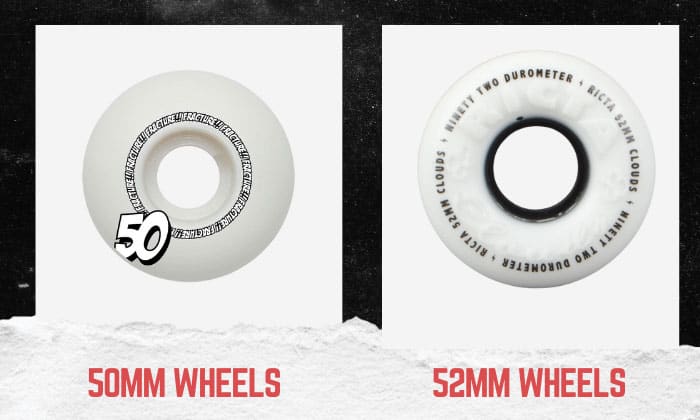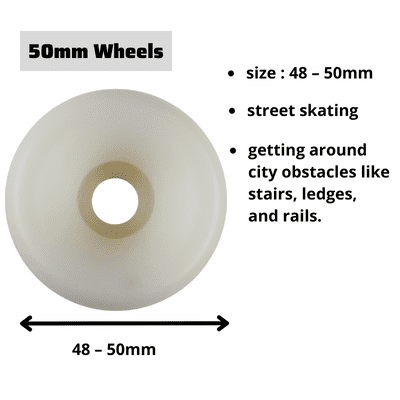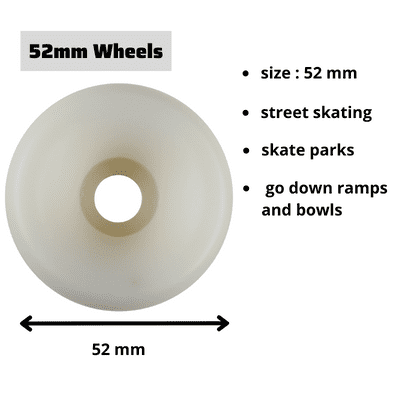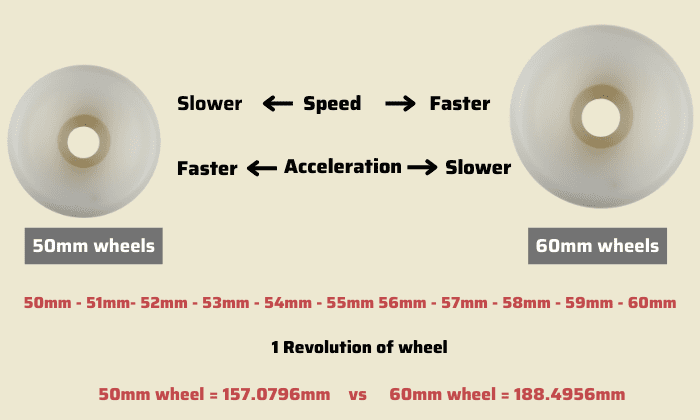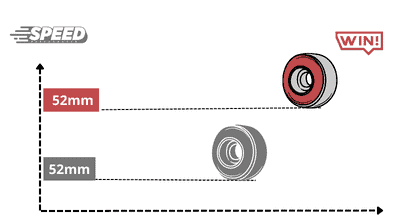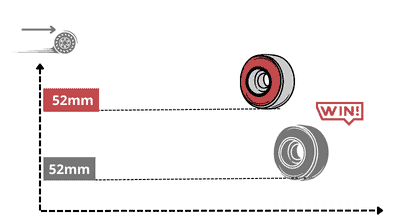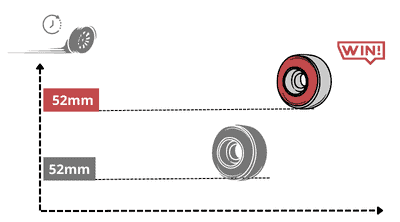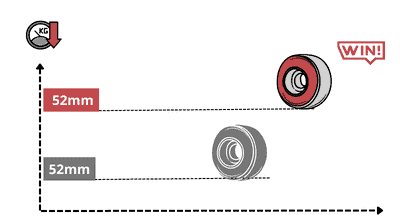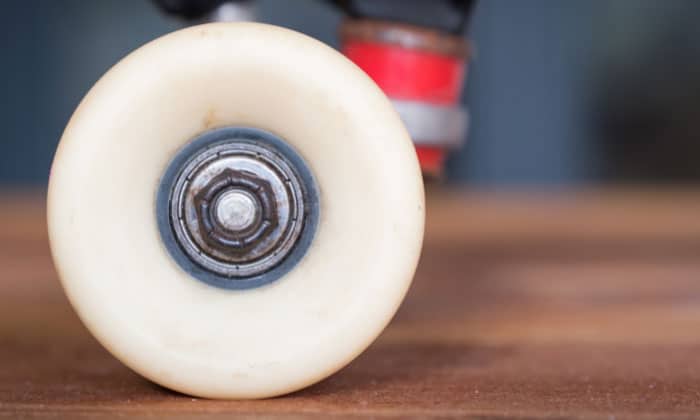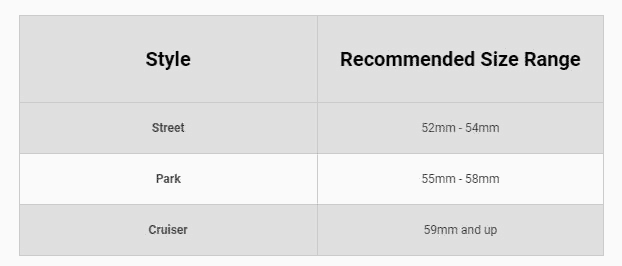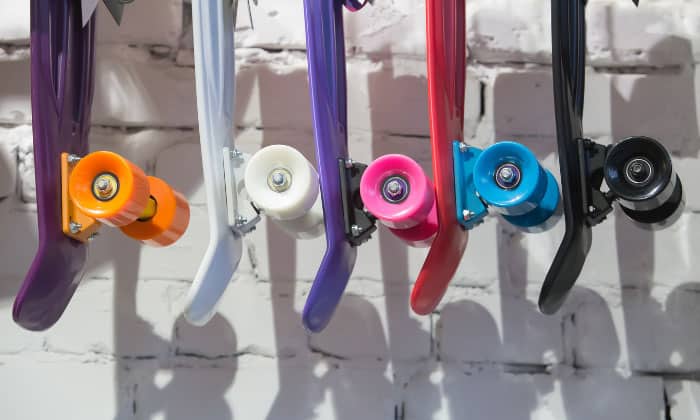When discussing the sizes of skateboards, we often head straight to the deck’s width, length, and wheelbase. Yes, these numbers are not negligible. But beyond these figures, there is another skateboard part size we should take significantly, the wheels.
And today, we will discuss two of the popular skateboard wheel dimensions. 50mm skateboard wheels VS 52mm wheels, how is one different from the other? Where do we use both sizes? What yields a better performance?
This wheel size comparison will answer all these questions and tell us more about these wheel sizes. By then, we’ll appreciate what a 2mm difference can do.
Table of Contents
50mm and 52mm Skateboard Wheels
For your information, wheels from 50mm to 53mm is the perfect size range for those who want to do the trick and technical skateboarding. What seems to be an irrelevant difference could be a game-changer as we define 50mm and 52mm skateboard wheels.
1. 50mm wheels
Made in the early 2000s, wheels of small sizes (48 – 50mm) were the mid-ancestors of skateboard rollers. While these are rare now, they allow exceptional rides back then.
If we are lucky to find 50mm today, such will be the perfect wheel size for street skating. And we know that this skateboarding style entails getting around city obstacles like stairs, ledges, and rails.
2. 52mm wheels
Similarly, 52mm wheels are good for street skating. The truth is, these are the most popular street skate rollers used today. And like the 50mm size, these are slower and smaller wheels.
If there’s one characteristic highlighted in a 52mm wheel, that’s their suitability in skate parks. These wheels make skaters go down ramps and bowls, to name a few.
Differences Between 50mm and 52mm Skate Wheels
We’ve seen how these wheels fit the more technical skate rides. Let’s now slide into their differences.
1. Speed
Refer to the chart below. The speed varies for every increment in a sizing scale ranging from 50mm to 60mm.
The 50mm wheels are on the lowest end of the scale. And checking the speed levels, these rollers move the slowest. Increasing the size, we’ll find 52mm. These are slightly better in speed.
Without memorizing the scale and its equivalent speed, there is an explanation for the smaller skateboard wheels traveling slower.
One total spin of a 50mm wheel equals 157.0796mm covered distance. So, the larger the wheel’s diameter, the longer the distance its contact patch covers in a single spin.
2. Acceleration
The same illustration above also determines the wheel’s acceleration. And in this aspect, 50mm wheels take the upper hand. Why?
The shorter revolution of a 50mm wheel enables the skateboard to accelerate faster. It allows skaters to push more, thus making the rollers complete more trajectories.
In effect, skateboards with smaller 50mm wheels can take off faster than boards with larger rollers.
3. Wearing out
Many skaters claim that larger wheels last longer than small ones. And such is most likely because they have thicker bodies to wear out.
If we apply this concept, which wears out longer between 50mm and 52mm wheels? It may not be too different, but 52mm rollers could last longer than 50mm.
3. Weight
While there is no published research about it, several skaters claim that the wheel’s size also affects the skateboard’s performance.
Essentially, the larger the wheel’s diameter, the heavier it is. So, 52 mm wheels could be denser than 50mm. But by how many grams? We can’t quantify it yet.
Pros and cons
50mm and 52mm wheels have almost unnoticeable differences. Nonetheless, let’s highlight their strengths and drawbacks here.
| 50mm wheels | 52mm wheels | |
| Pros | – Faster acceleration
– Deemed to be lighter – Great for street skating – Smooth rides
|
– Better speed
– Works on streets plus parks – Good maneuverability – Ideal for flipping tricks – Good for beginners |
| Cons | – Lower speed
– Wears out faster |
– Slower acceleration
– Deemed to be heavier |
The Similarities Between 50mm and 52mm Skateboard Wheels
Checking a skateboard wheel size chart, we often find 50mm and 52mm wheels in the same range. Let’s get into their similarities.
1. Both wheels cannot contain rough skating surfaces.
Smaller wheels do not work well when skating on pavements with road debris like pebbles, cracks, or fallen tree objects. Consequently, using them in these spots could cause instability or adverse effects.
2. Prone to flat-spotting.
What is flat-spotting? It happens when you slide against the wheel’s rolling direction. And yes, 50mm and 52mm rollers could be prone to this problem because of their shorter wearing-out time.
3. Both are good for street skateboarding
These small-sized wheels are ideal for street skating of any type. Beginners can start their practice of skateboarding tricks with these two.
Tips for Choosing the Right Wheel Size
What size wheels for skateboard? Let’s first match the sizes with the following items in this skateboard wheels guide.
1. Wheel type
There are three wheel types; longboard, cruiser, and regular skateboard for park and street spots.
Longboard wheels are the biggest skateboard wheels at 60mm to 75mm. Cruisers follow with 54mm to 60mm. And skateboard rollers span from 50mm to 60mm.
So, whatever skating style we want, let’s align it with these sizes.
2. Hardness level
The durometer or hardness level also indicates what surface types a skateboard wheel can take.
For rough surfaces, it’s best to use a soft standard skateboard wheel durometer at 78a to 87a. If you want an all-around wheelset that exhibits optimum control and speed, 90a to 97a wheels are ideal. Ultimately, if you mainly skate for tricks, 99a rollers work best.
3. Shape
Not only do skateboard decks have shapes but wheels too.
These shapes are classic and conical. Conical-shaped wheels are lighter and have a larger rolling surface. On the other hand, classically shaped rollers might have narrower contact exteriors, but they offer better speed.
Frequently Asked Questions
Are 52mm wheels ideal for beginners?
Generally, larger wheels are the average skateboard wheel sizes, for beginners. And between 50mm and 52mm wheels, the latter takes it.
However, there are better starter wheel sizes for beginners. Beginner wheels begin somewhere at 54mm, looking at the scale. And the largest these skaters can use goes around 59mm.
Are bigger wheels better for skateboarding?
Each skateboard wheel size, hardness, shape, and style imposes significant benefits we cannot find in another variant. Both bigger and smaller wheels work well for skateboarding. But it depends on what skating style we use.
Amplifying the advantages of large skateboard wheels, they work best on almost any terrain. Also, these rollers are slightly more comfortable than the smaller ones.
You can also use big skate wheels for speed and transition skating or the largest skateboard wheels for longboarding for an added thrill.
Conclusion
The so-called minor or insignificant differences among skateboard parts always have a purpose. There isn’t a 1-inch or 2-mm difference in skate decks and wheels for nothing. But we will only appreciate these changes if we look at the scales.
So, between 50mm skateboard wheels VS 52mm, we have finally seen how they matter in speed, acceleration, weight, and lifespan. Variations could be little, but impact begins in small increments.
Remember, more factors need consideration when buying skateboard wheels. Be sure to check all of them.

Hi, I am Charles Harris. I opened this site to write as much as I can about my biggest passion – skateboarding!
I started as a clumsy yet passionate rookie 10 years ago to now a still passionate yet much better skateboarder! But I have to tell you, the whole journey has always been fun and rewarding, indeed not without hardship.


